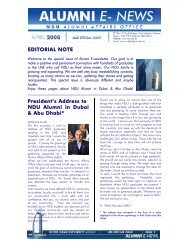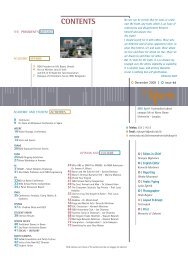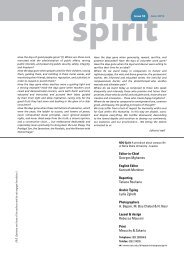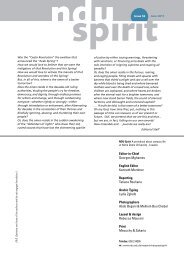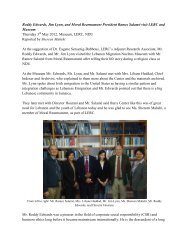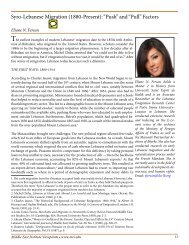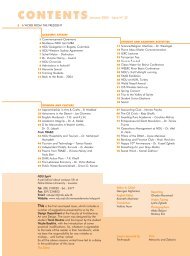OUTLINE - Notre Dame University
OUTLINE - Notre Dame University
OUTLINE - Notre Dame University
You also want an ePaper? Increase the reach of your titles
YUMPU automatically turns print PDFs into web optimized ePapers that Google loves.
The September attack also brought<br />
claims for business interruption from<br />
policy holders in various business<br />
sectors and in different geographical<br />
locations (duty-free shop operators<br />
at Miami Airport, principals of the<br />
Carnival cruise liner, owners of casinos<br />
in Las Vegas, etc.)<br />
Property Damages Forecast<br />
In America the War Exclusion clause<br />
features in each property insurance<br />
policy, while there is silence about<br />
Terrorism coverage, which remains<br />
available upon the request of the<br />
insured, subject to an added premium.<br />
The structures of W.T.C. (both towers)<br />
were insured for $ 3.2 billion,<br />
plus $ 1.2 billion coverage against<br />
business interruption loss. United<br />
Airlines and American Airlines,<br />
whose aircraft crashed into W.T.C.,<br />
were insured against third party liability<br />
for $ 1.75 billion per single<br />
event. Insurance companies are<br />
debating whether to consider the<br />
attacks as a single event or as a<br />
series, since some pertinent insurance<br />
policies carry a single limit of<br />
liability while others bear a combined<br />
(aggregate) limit of liability.<br />
The US government will assume the<br />
property loss in the Pentagon structure<br />
as most government buildings<br />
are self-insured.<br />
The Association of Trial Lawyers of<br />
America, personal injury lawyers,<br />
have called for a moratorium on civil<br />
suits related to the attack. Possible<br />
defendants in litigation, apart from<br />
the two airlines, include Boston and<br />
New York airport security firms,<br />
Boeing and Airbus the aircraft<br />
builders, The Port Authorities of<br />
New York and New Jersey on<br />
account of a joint ownership of<br />
W.T.C., architects and builders, the<br />
leasing company Silverstein<br />
Consortium, the US Federal Aviation<br />
Administration, the Massachusetts<br />
Port Authority and the insurance<br />
broker (for supplying inadequate<br />
limit of liability on the W.T.C. insurance<br />
programs.)<br />
The Government<br />
Assistance Role<br />
Insurance companies may have an<br />
ally in their repudiation of most<br />
claims in view of the War Exclusion<br />
clause in property insurance programs,<br />
for in his speech of<br />
September 11 President Bush branded<br />
the attacks as an Act of War. But<br />
ducking such claims might back-fire<br />
on the insurance industry. Moreover<br />
the Afghanistan war has exacerbated<br />
an already nervous insurance market.<br />
Following the attacks, driven by<br />
national interests involved in private<br />
sectors concerned with drafting terrorism<br />
insurance, governments in<br />
the industrial world will let the private<br />
sector pick up the first-loss layer<br />
and themselves assume the excessive-loss<br />
layer. The government policies<br />
have two aims, avoiding a collapse<br />
of the insurance industry and<br />
providing proper terrorism coverage<br />
for domestic fixed assets so that they<br />
will not be vulnerable to unpredictable<br />
perils.<br />
The US Senate has debated whether<br />
the American Government should<br />
be the insurer of last resort, as conglomerates<br />
facing many claims from<br />
September 11 think it should. In<br />
December 2002, the American<br />
Congress passed a bill authorizing<br />
the Treasury Department to provide<br />
insurance coverage for losses in<br />
excess of $ 10 billion up to $ 100 billion<br />
in the event of a terrorist attack<br />
occurring on United States soil. E.U.<br />
governments have agreed to provide<br />
one-month terrorism coverage for<br />
uninsurable or under-insurable<br />
assets in Europe. The US Congress<br />
passed an emergency act for paying<br />
American national airlines back for<br />
their terrorism insurance up to 180<br />
days, and worked on a rescue plan<br />
for the insurance industry where the<br />
latter would assume the first $ 10 billion<br />
in claims and the Government<br />
would pick up 90% of the balance in<br />
excess of the sum; however, during<br />
December 2001 the bill was stalled in<br />
the Senate.<br />
The Insurance Bill<br />
During the 1990s, companies could<br />
underwrite coverage at a loss as they<br />
could use the cash-flow from premiums<br />
and invest it in the equity market<br />
for a sound return. But the overall<br />
costs for insurance of the<br />
September 11 attacks have been put<br />
at $ 70 billion. US companies are<br />
expected to pay out half the amount.<br />
Insurance providers hardest hit<br />
include Lloyd’s of London ($ 2.7 billion<br />
loss), Berkshire Hathaway ($ 2.5<br />
billion loss), Munich Re ($ 2 billion<br />
loss), Swiss Re ($ 1.5 billion loss),<br />
Allianz ( $ 1 billion loss), Zurich-Re (<br />
$ 1 billion loss) and A.I.G., Score,<br />
CNA, Cigna and St. Paul for lesser<br />
amounts.<br />
Conclusion<br />
The American insurance industry is<br />
likely to get away without any major<br />
bankruptcy; survivors being generally<br />
well capitalized organizations,<br />
the demand for their services will<br />
increase. Premiums have already<br />
been marked up; health care is<br />
expected to rise by 20% and insurance<br />
for apartments in major cities<br />
by 100 – 300 %. Sky-rocketing premiums<br />
have forced insurance buyers to<br />
impose purchasing discipline on<br />
their risk transfer policy. At the same<br />
time the shortage in market capacity<br />
has forced the insurance organizations<br />
to scrutinize their underwriting<br />
exposures and to become more<br />
selective in the use of their capital.<br />
This trend will continue for some<br />
time, while industry barriers go<br />
higher, available insurance capacity<br />
is limited and demands for specialty<br />
coverage rise. At this juncture a wellmanaged<br />
insurance carrier will take<br />
advantage of this business opportunity<br />
to capitalize on it and to put to<br />
work its competitive advantage.<br />
For the purposes of NDU Spirit this<br />
paper has been shortened slightly<br />
and updated. –Ed.<br />
44 NNU SPIRIT



